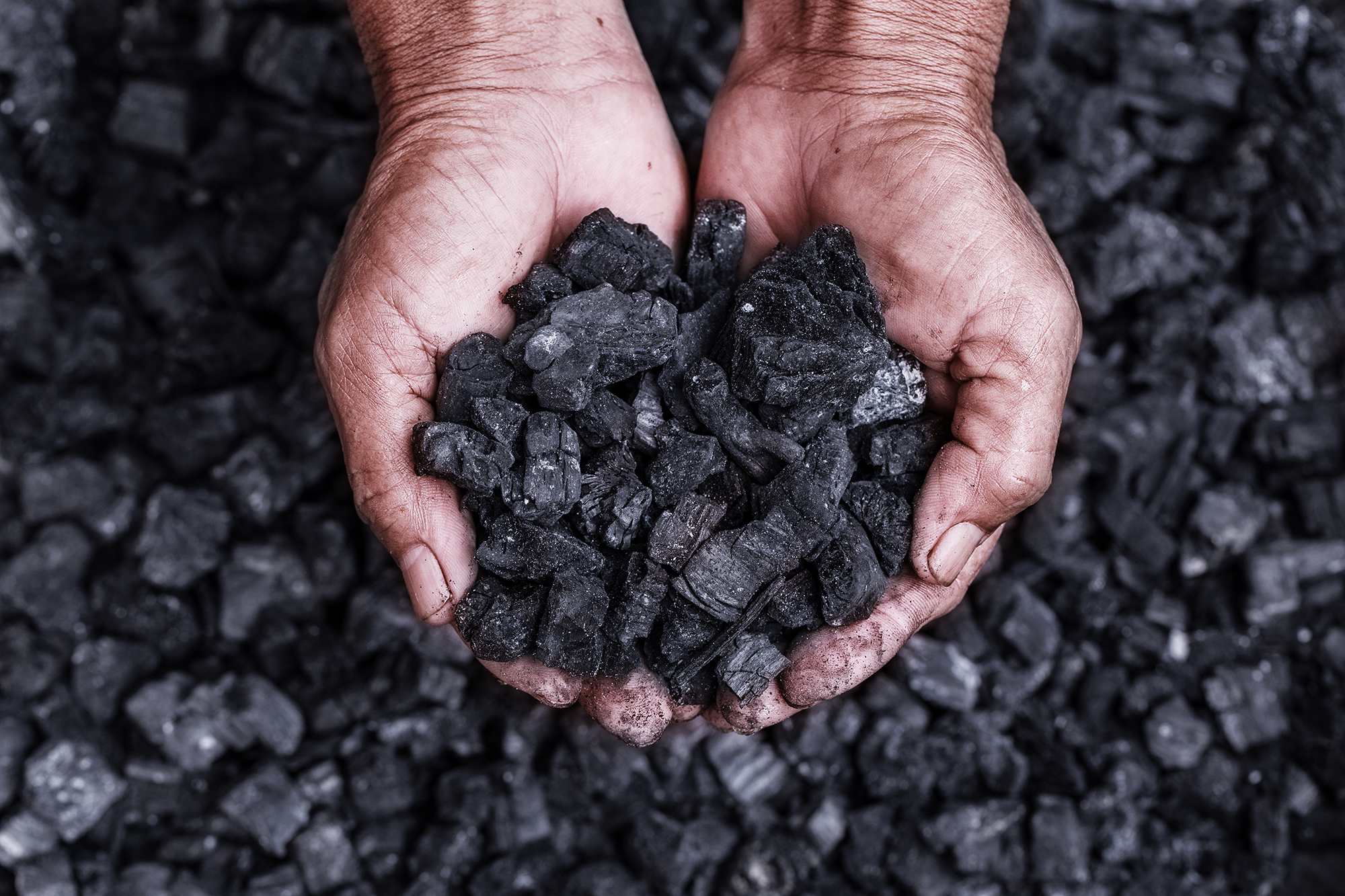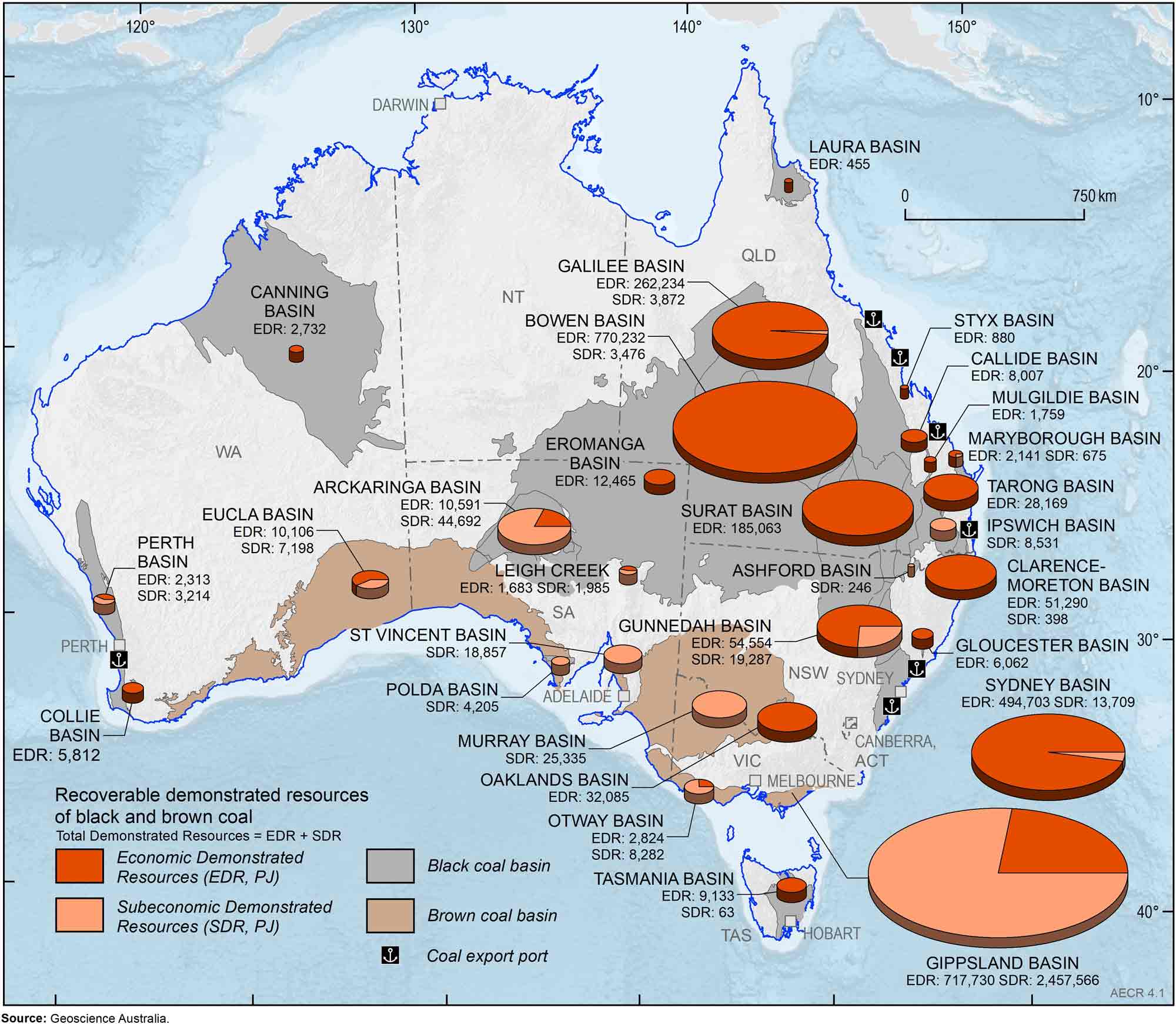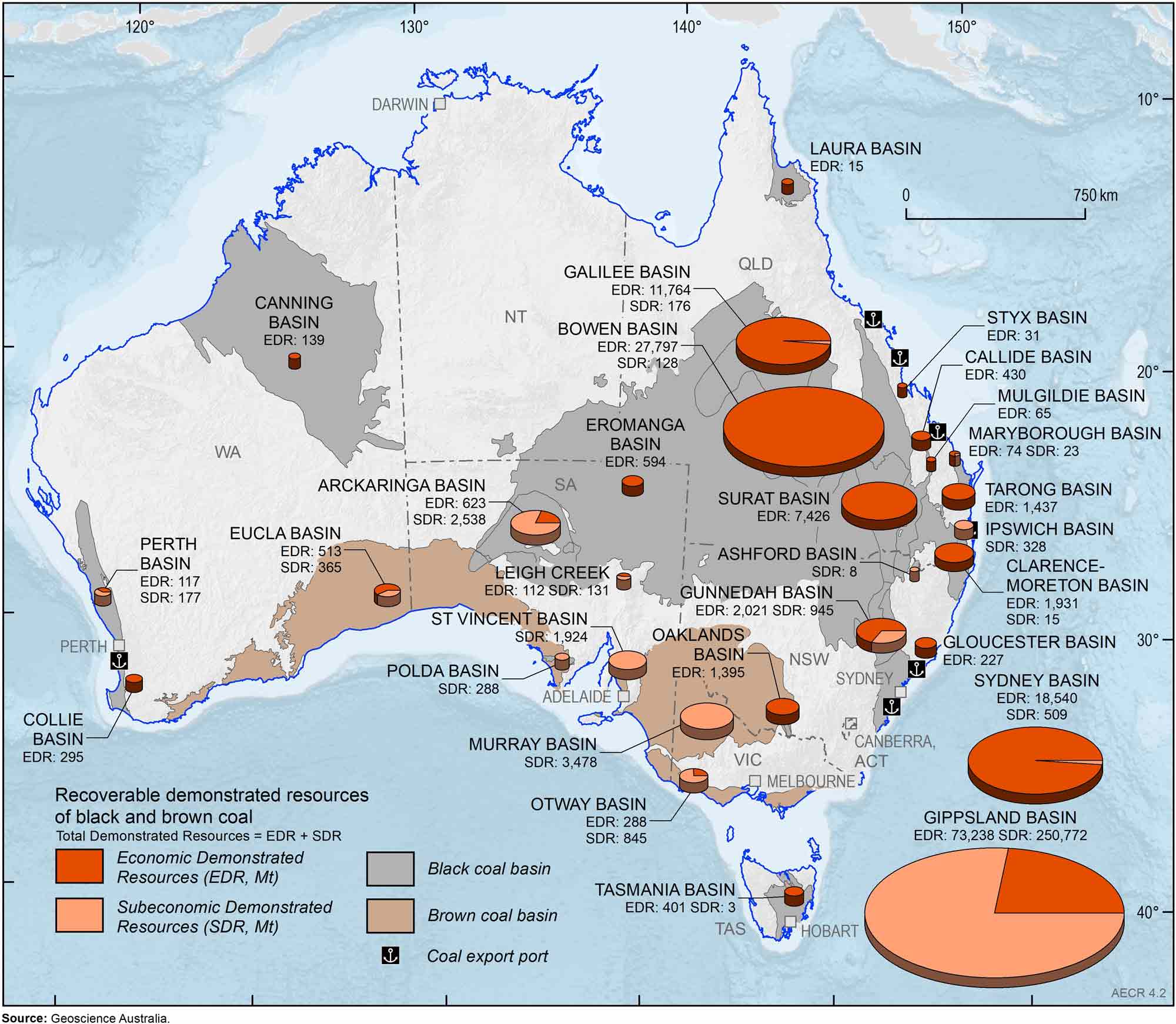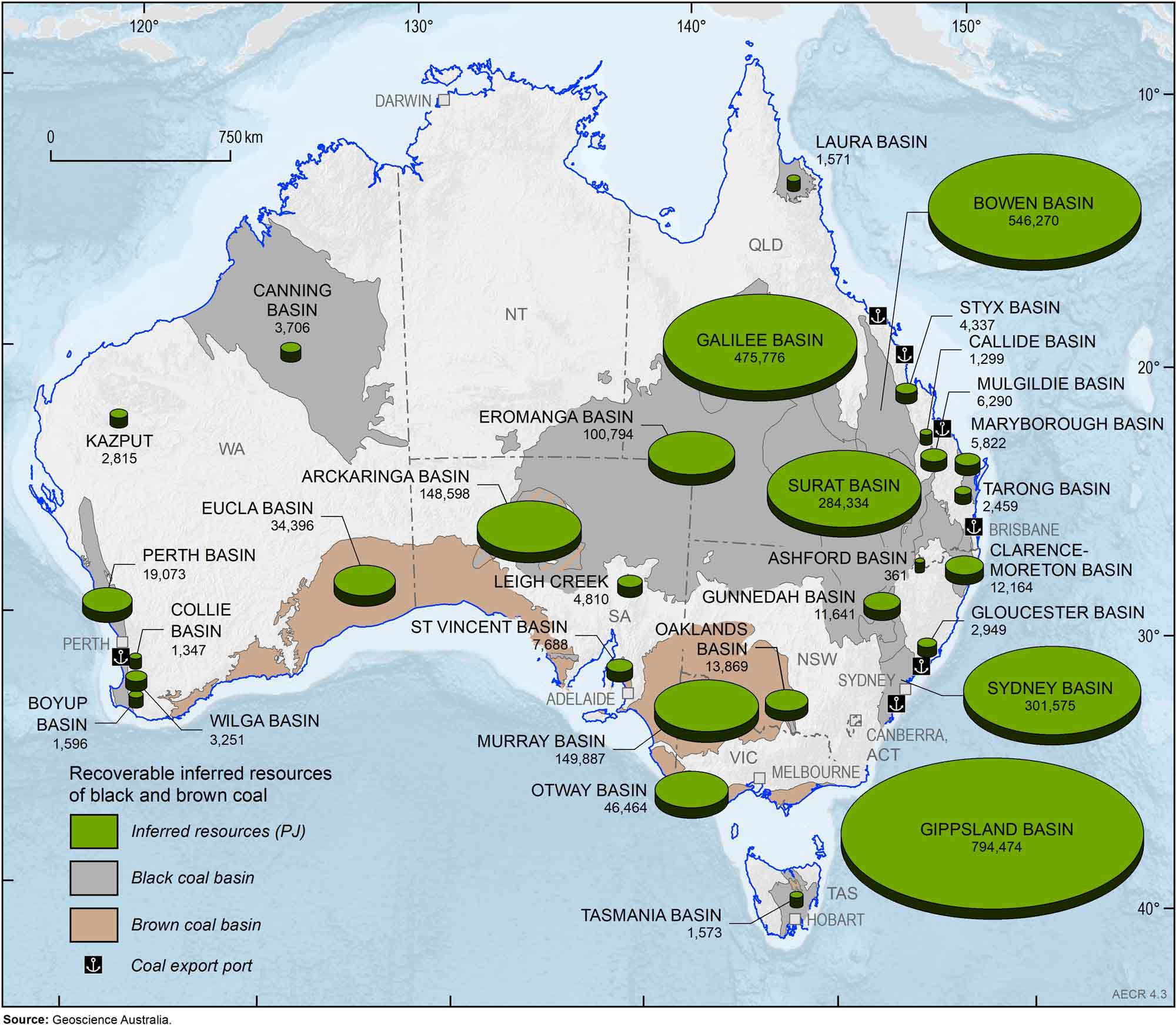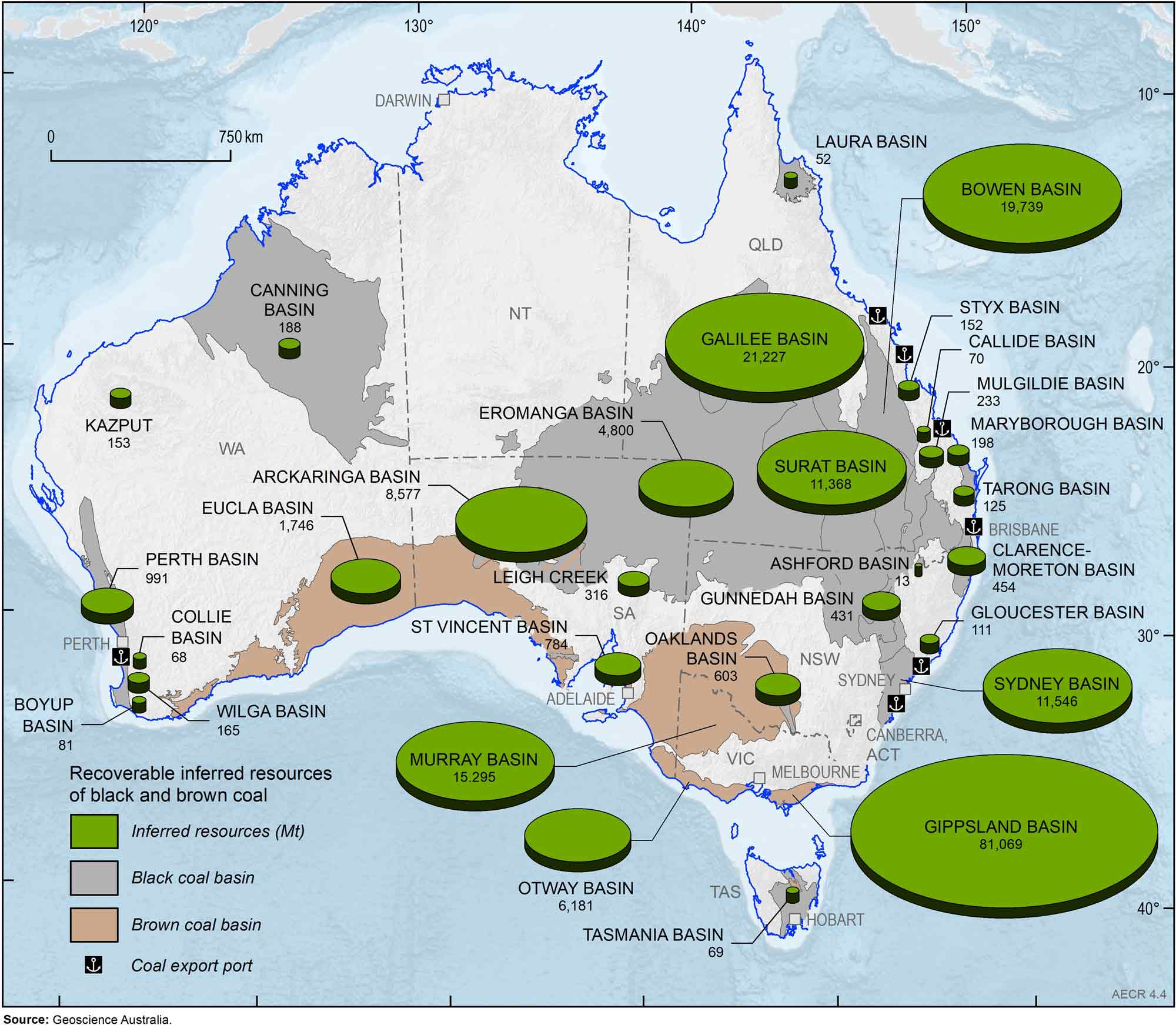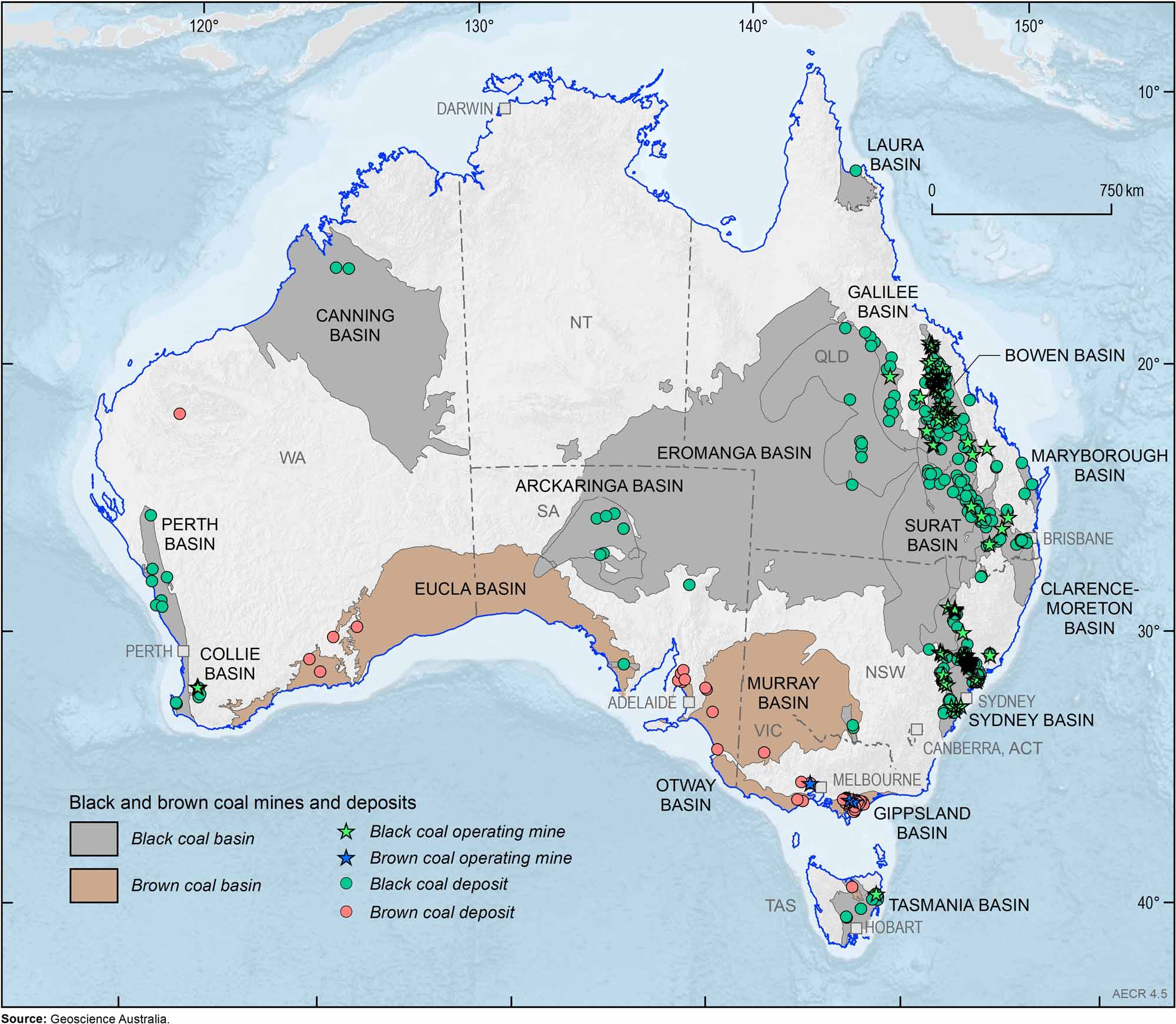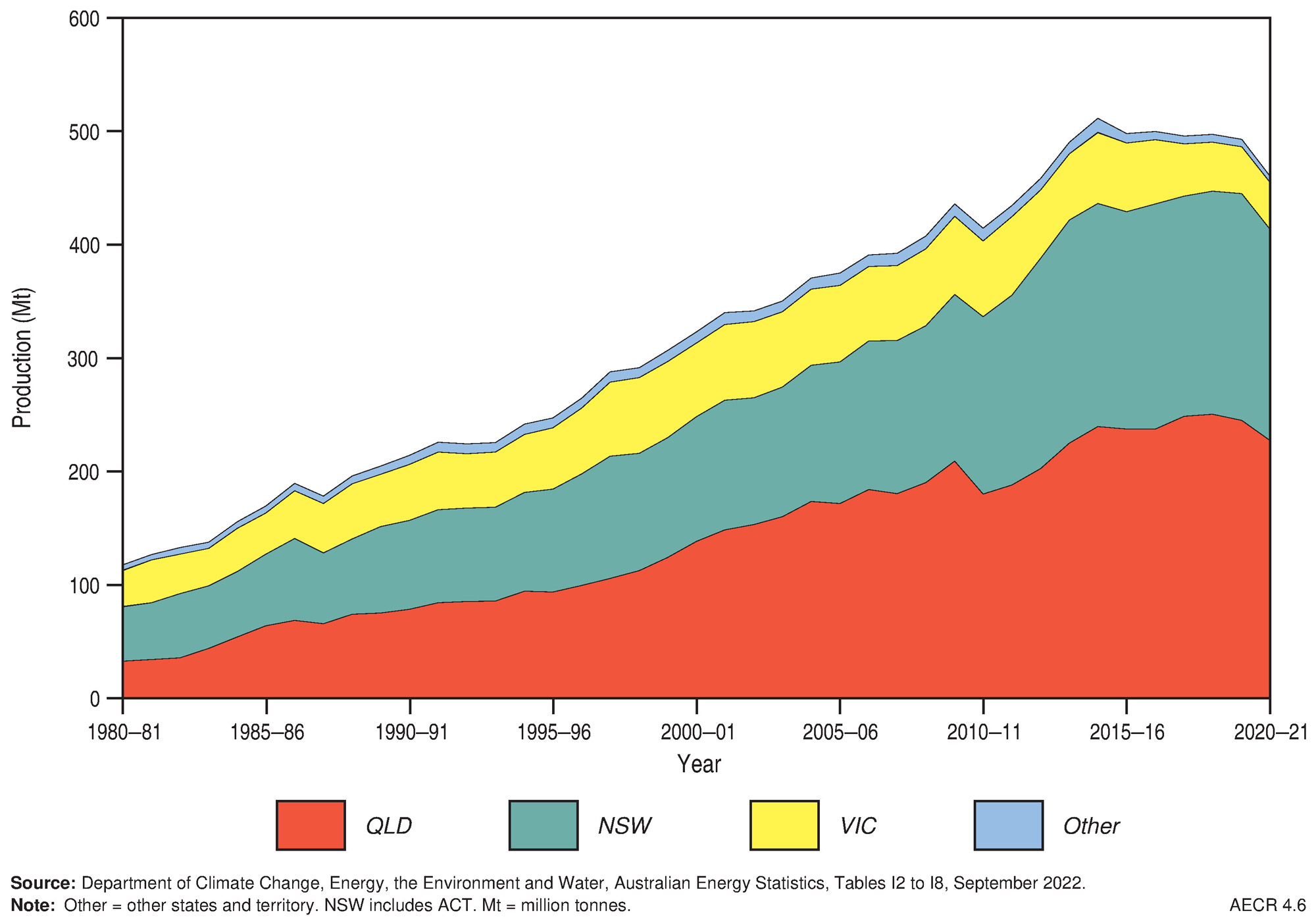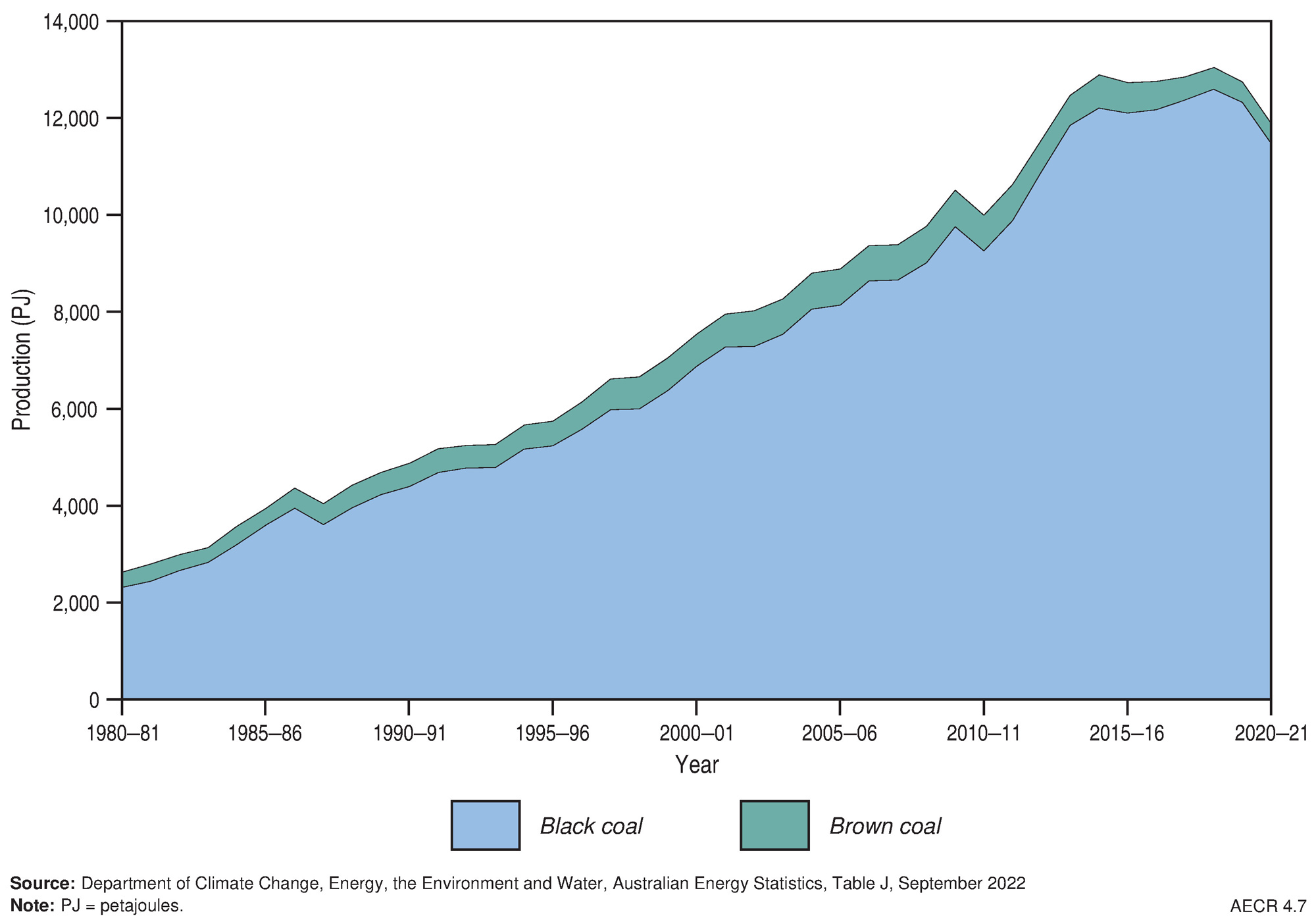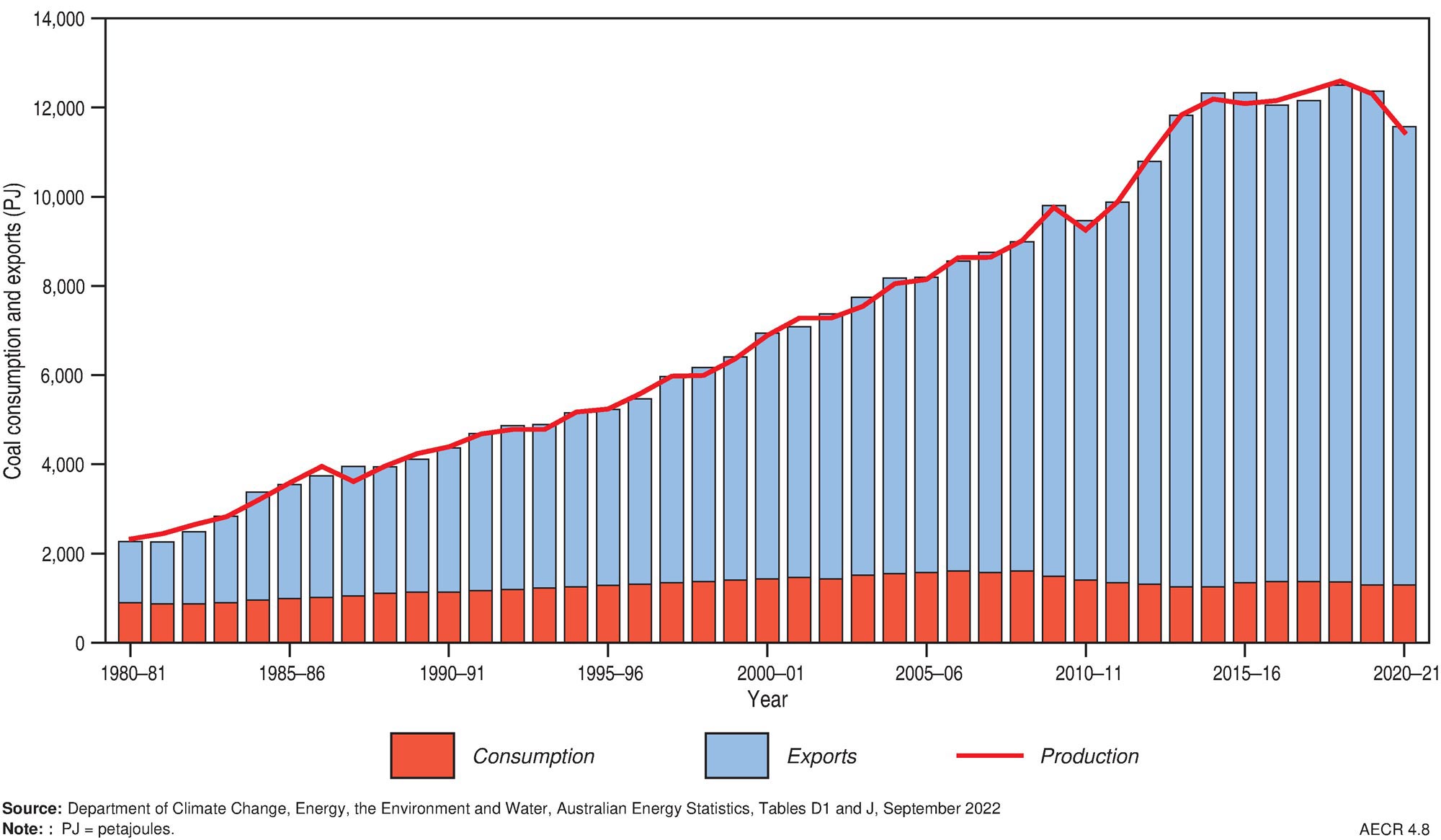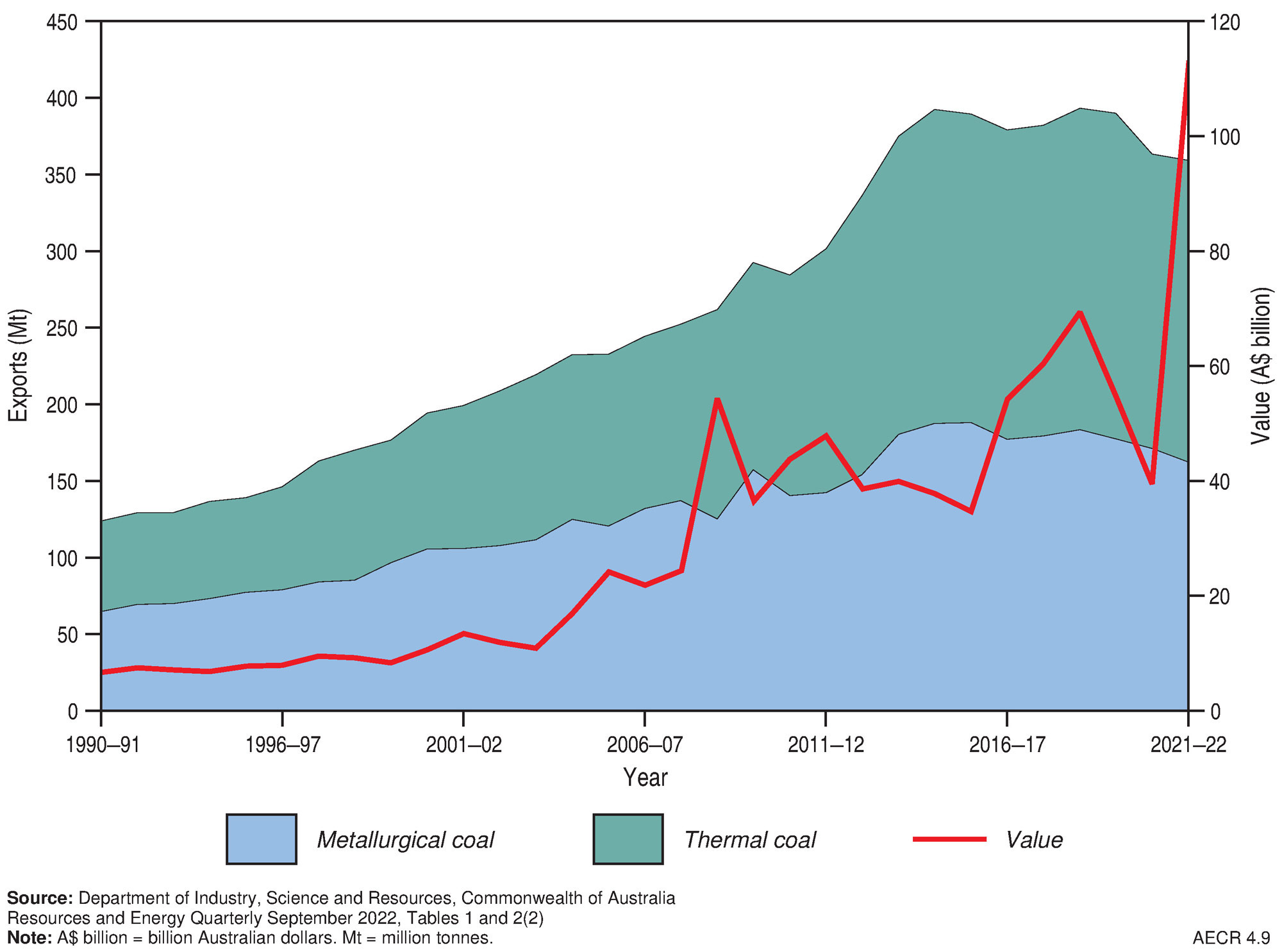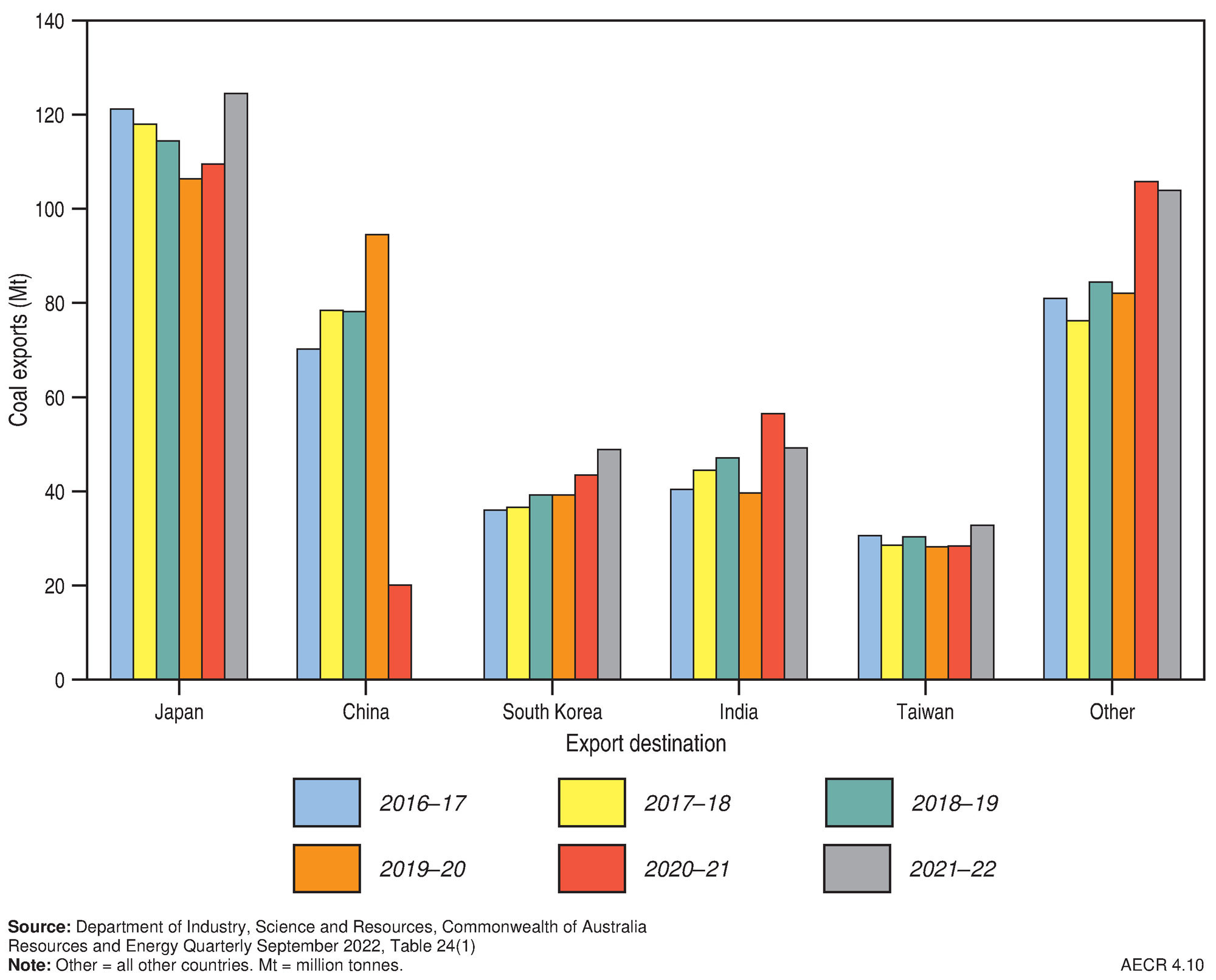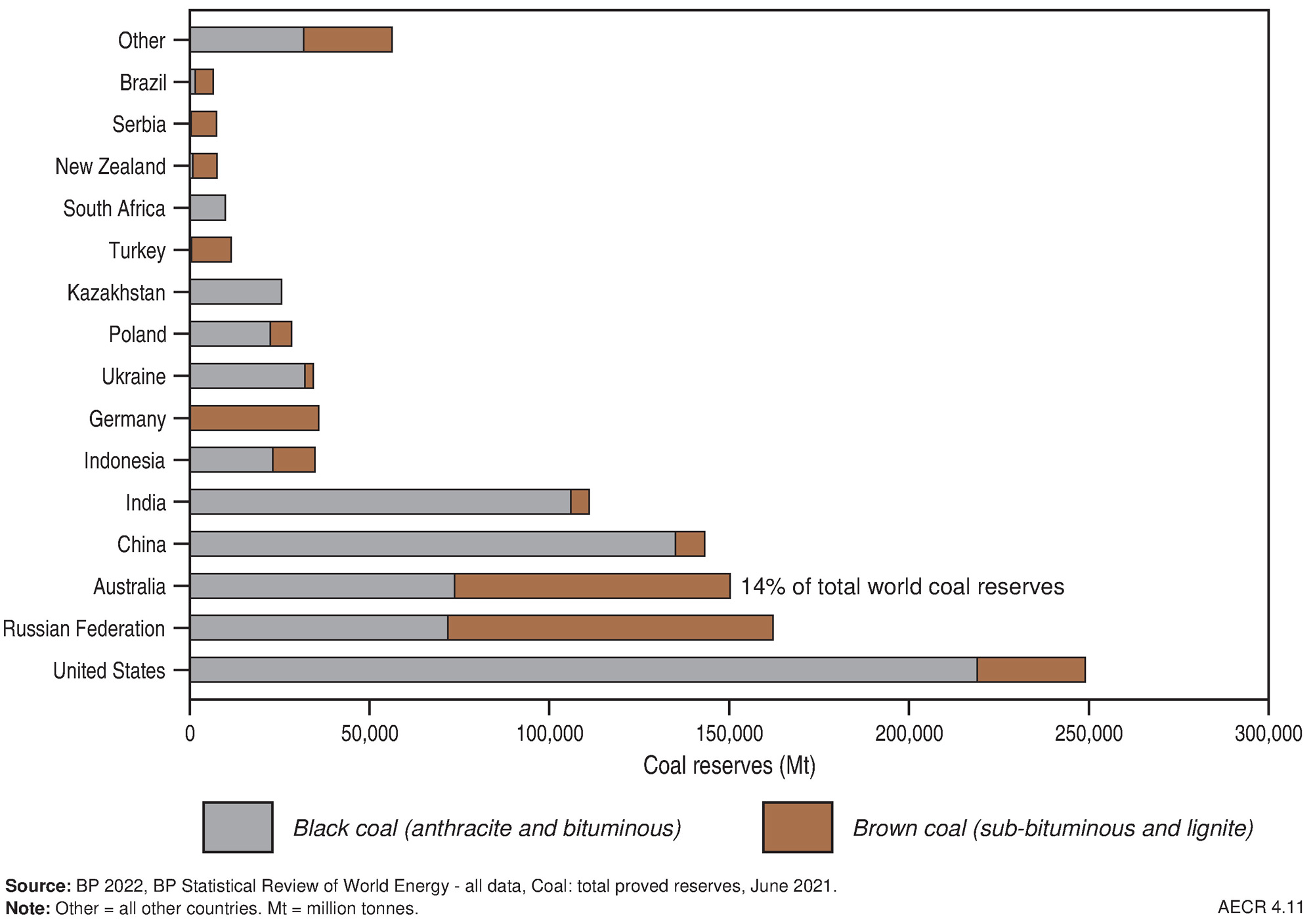Key messages
- Coal is a sediment that is largely composed of plant remains. It is formed when the accumulated plant matter is buried under anoxic conditions and exposed to increased temperatures and pressures over a long period of time (millions of years).
- Coal ranking, that is peat, lignite, sub-bituminous, bituminous and anthracite, are expressed on the degree of plant matter alteration. The latter three ranks are commonly referred to as “black coal” while lignite is commonly called “brown coal”.
- Coal is Australia’s largest energy resource. At the end of 2021, Australia’s recoverable Economic Demonstrated Resources were 75,433 million tonnes (Mt) of black coal and 74,039 Mt of brown coal.
- Australia is the fifth largest producer, the second largest exporter and has the third largest reserves of coal in the world.
Summary
Australia’s coal resources are among the largest in the world (Figure 1; Figure 2). In 2021, in situ Economic Demonstrated Resources (EDR) of black coal were 89,012 million tonnes (Mt) and brown coal amounted to 81,234 Mt (Figure 2).
Recoverable resources, however, provide a more accurate assessment of coal endowment as it includes losses that occur during mining and processing. As at December 2021, Australia’s total recoverable Identified Resources of black coal were estimated at 162,279 Mt, of which recoverable EDR were 75,433 Mt (Figure 2). Australia is ranked fourth, globally, for economically demonstrated black coal resources after the United States, China and India.
At December 2021, the total recoverable Identified Resource of brown coal was estimated at 436,652 Mt, of which recoverable EDR were 74,039 Mt (Figure 2). Globally, Australia is ranked second for economic demonstrated brown coal resources, behind Russia.
In Australia, black coal is produced in Queensland, New South Wales, Western Australia, South Australia and Tasmania with the majority exported to overseas markets. At the end of 2021, export earnings from black coal totalled $63.51 billion, up from $43.37 billion at the end of 2020 (Department of Industry, Science and Resources, 2023). Japan and other Asian countries are prime destinations for Australian coal (see “Trade” section below).
In 2021, coal exploration expenditure was $226.2 million, a decrease of 22.4 per cent on 2020 ($291.6 million). Much of the expenditure occurred in Queensland, and coal exploration was approximately 6 per cent of the 2021 total exploration spend (Australian Bureau of Statistics, 2023).
Australia's identified resources
Australia’s coal resources are expressed as Economic Demonstrated Resources (EDR), Subeconomic Demonstrated Resources and Inferred Resources as defined below:
- Economic implies that, at the time of determination, profitable extraction or production under defined investment assumptions has been established, analytically demonstrated, or assumed with reasonable clarity;
- Demonstrated Resources are the sum of Measured and Indicated Resources, including Proved and Probable Reserves as defined by the Australasian Code for Reporting of Exploration Results, Mineral Resources and Ore Reserves also called the 'JORC Code' (Joint Ore Reserves Committee [JORC], 2012);
- Subeconomic refers to those resources that are geologically demonstrated but which do not meet the criteria of economic at the time of determination; and
- Inferred Resources, as defined by the ‘JORC Code’,are the part of a Mineral Resource for which quantity and grade are estimated on limited geological evidence and sampling. Geological evidence is sufficient to imply, but not verify, geological and grade continuity. An Inferred Mineral Resource has a lower level of confidence than an Indicated Resource and must not be converted to an Ore Reserve.
- Coal Resource(s) and Coal Reserve(s), according to the ‘JORC Code’, the terms Mineral Resource and Ore Reserve apply to coal reporting but may be substituted with the terms Coal Resource and Coal Reserve. Coal, whilst a sediment rather than a mineral, is captured by the ‘JORC Code’ because the ‘JORC Code’ applies to solid materials of economic interest, and is “mined”, as opposed to liquid oil or gas resources which “flow” out of the surrounding rock.
At 31 December 2021, Australia had substantial EDR (Table 1 and Table 2; Figure 1 and Figure 2) and Inferred Resources (Table 1 and Table 2; Figure 3 and Figure 4) of black and brown coal.
Black coal
Most of Australia’s black coal EDR is in Queensland and New South Wales, followed by South Australia, Western Australia and Tasmania. There are two main types of black coal products: metallurgical coal and thermal coal. Metallurgical coal (also called met coal or coking coal) is mostly used for steel making and other industrial processes. Thermal coal (also called steaming coal) is used for electricity generation.
Total in-situ resources of black coal in Australia (EDR plus Subeconomic Demonstrated Resources plus Inferred Resources) are estimated at 200,333 Mt, comprising 89,012 Mt of EDR, 7,113 Mt of Subeconomic Demonstrated Resources and 104,208 Mt of Inferred Resources. Australia’s total recoverable Identified Resources of black coal are estimated to be 162,279 Mt, comprising 75,433 Mt of EDR, 5,269 Mt of Subeconomic Demonstrated Resources and 81,577 Mt of Inferred Resources (Table 1).
In 2021, the estimate of Australia’s recoverable EDR of black coal was revised upwards from 74,147 Mt to 75,433 Mt, an increase of 1,286 Mt, or 1.7 per cent, from the previous year. The modest increase in EDR was supported by additions from Queensland’s Bowen Basin at Peak Downs (BHP Mitsubishi Alliance) and a maiden resource announcement at Hillalong North (Bowen Coking Coal).
Brown coal
Total in situ resources (all categories) of brown coal, are estimated to be 488,664 Mt, of which in situ EDR are 81,234 Mt, Subeconomic Demonstrated Resources are 284,921 Mt and Inferred Resources are 122,509 Mt. Total recoverable Identified resources of brown coal are estimated at 436,652 Mt, of which recoverable EDR are 74,039 Mt, Subeconomic Demonstrated Resources are 257,385 Mt and Inferred Resources are 105,228 Mt. Nearly all of Australia’s recoverable brown coal EDR is in Victoria, with more than 90 per cent in the Gippsland Basin (Latrobe Valley).
Table 1. Australia's remaining black coal resources by basin area to year end 2021 (Mt and PJ)
| Province | Black Coal | |||||
|---|---|---|---|---|---|---|
| EDR (Mt) | SDR (Mt) | Inferred (Mt) | EDR (PJ) | SDR (PJ) | Inferred (PJ) | |
| Arckaringa Basin | 623 | 2,538 | 8,577 | 10,591 | 44,692 | 148,598 |
| Ashford Basin | 0 | 8 | 13 | 0 | 246 | 361 |
| Bowen Basin | 27,797 | 128 | 19,739 | 770,232 | 3,476 | 546,270 |
| Boyup Basin | 0 | 0 | 81 | 0 | 0 | 1,596 |
| Callide Basin | 430 | 0 | 70 | 8,007 | 0 | 1,299 |
| Canning Basin | 139 | 0 | 188 | 2,732 | 0 | 3,706 |
| Clarence-Moreton Basin | 1,931 | 15 | 454 | 51,290 | 398 | 12,164 |
| Collie Basin | 295 | 0 | 68 | 5,812 | 0 | 1,347 |
| Eromanga Basin | 594 | 0 | 4,800 | 12,465 | 0 | 100,794 |
| Galilee Basin | 11,764 | 176 | 21,227 | 262,234 | 3,872 | 475,776 |
| Gloucester Basin | 227 | 0 | 111 | 6,062 | 0 | 2,949 |
| Gunnedah Basin | 2,021 | 945 | 431 | 54,554 | 19,287 | 11,641 |
| Ipswich Basin | 0 | 328 | 0 | 0 | 8,531 | 0 |
| Laura Basin | 15 | 0 | 52 | 455 | 0 | 1,571 |
| Leigh Creek | 112 | 131 | 316 | 1,683 | 1,985 | 4,810 |
| Maryborough Basin | 74 | 23 | 198 | 2,141 | 675 | 5,822 |
| Mulgildie Basin | 65 | 0 | 233 | 1,759 | 0 | 6,290 |
| Oaklands Basin | 1,395 | 0 | 603 | 32,085 | 0 | 13,869 |
| Pedirka Basin | 0 | 0 | 0 | 0 | 0 | 0 |
| Perth Basin | 117 | 177 | 991 | 2,313 | 3,214 | 19,073 |
| Polda Basin | 0 | 288 | 0 | 0 | 4,205 | 0 |
| Styx Basin | 31 | 0 | 152 | 880 | 0 | 4,337 |
| Surat Basin | 7,426 | 0 | 11,368 | 185,063 | 0 | 284,334 |
| Sydney Basin | 18,540 | 509 | 11,546 | 494,703 | 13,709 | 301,575 |
| Tarong Basin | 1,437 | 0 | 125 | 28,169 | 0 | 2,459 |
| Tasmania Basin | 401 | 3 | 69 | 9,133 | 63 | 1,573 |
| Wilga Basin | 0 | 0 | 165 | 0 | 0 | 3,251 |
| Total | 75,433 | 5,269 | 81,577 | 1,942,362 | 104,352 | 1,955,465 |
Notes: Additional coal resources are also present outside of these basin areas, which are included in the totals documented in AECR. The data shown have been rounded. EDR = economic demonstrated resources. SDR = sub-economic demonstrated resources. Mt = million tonnes. PJ = petajoules. Source: Geoscience Australia OZMIN database, accessed 11 October 2022.
Table 2. Australia's remaining brown coal resources by basin area to year end 2021 (Mt and PJ)
| Basin | Brown Coal | |||||
|---|---|---|---|---|---|---|
| EDR (Mt) | SDR (Mt) | Inferred (Mt) | EDR (PJ) | SDR (PJ) | Inferred (PJ) | |
| Eucla | 513 | 365 | 1,746 | 10,106 | 7,198 | 34,396 |
| Gippsland | 73,238 | 250,772 | 81,069 | 717,730 | 2,457,566 | 794,474 |
| Kazput* | 0 | 0 | 153 | 0 | 0 | 2,815 |
| Murray | 0 | 3,478 | 15,295 | 0 | 25,355 | 149,887 |
| Otway | 288 | 845 | 6,181 | 2,824 | 8,282 | 46,464 |
| St Vincent | 0 | 1,924 | 784 | 0 | 18,857 | 7,688 |
| Total | 74,039 | 257,385 | 105,228 | 730,660 | 2,517,239 | 1,035,724 |
Notes: Additional coal resources are also present outside of these basin areas, which are included in the totals documented in AECR. The data shown have been rounded. EDR = economic demonstrated resources. SDR = sub-economic demonstrated resources. Mt = million tonnes. PJ = petajoules. *Kazput is a deposit. Source: Geoscience Australia OZMIN database, accessed 11 October 2022.
Production
During 2021, Australia had 91 operating black coal mines, 3 operating brown coal mines (Figure 5), and more than 200 known coal deposits. Most of Australia’s black coal mines are in Queensland and New South Wales, which accounted for approximately 50 per cent and 40 per cent, respectively, of Australia’s 2020–21 coal production (Figure 6). Brown coal produced in Victoria, mainly from the Gippsland Basin, contributed 9 per cent of total coal production in 2020–21 (Department of Climate Change, Energy, the Environment and Water 2022a).
In 2020–21, Australia’s production of saleable black and brown coal was 11,894 PJ, which accounted for 54 per cent of total energy production (including uranium production; Department of Climate Change, Energy, the Environment and Water 2022b). Over the past decade, coal production has increased by an average annual rate of 1.2 per cent. This increase was moderated by falls in 2015–16, in 2019–20 due to the impact of COVID-19 on global demand, and, in 2020-21 due to the impact of extreme weather conditions on supply chains (Figure 7). In 2020–21, 90 per cent of Australia’s black coal energy production was exported (Figure 8).
Trade
Australia exports the majority of its coal, capitalising on its abundant coal resources and strong ongoing coal demand from Asia. Australia exported 10,324 PJ of coal and coal products in 2020–21, which was about 56 per cent of Australia’s total energy exports (including uranium exports; Department of Climate Change, Energy, the Environment and Water 2022c). The total value of coal exports declined by an average rate of 1.1 per cent per year from $48.01 billion in 2011–12 to $39.2 billion in 2020–21 (Figure 9).
Whilst coal exports to China were on hold in 2021–22, exports to Japan, South Korea and Taiwan increased and exports to India and other destinations remained relatively high (Figure 10). Coal export volumes have grown at an average annual rate of 2.5 per cent from 302 Mt in 2011–12 to 363 Mt in 2020–21; however, in 2021–22 Australian coal production was constrained, and exports decreased during the year (Department of Industry, Science and Resources, 2023). Underpinned by disruptions to production and supply chains, the average Newcastle thermal coal spot price increased to US$135/t in 2021, compared to US$58/t in 2020, and the Australian east coast premium hard coking coal spot price averaged US$225/t, compared to US$125/t in 2020 (Department of Industry, Science, Energy and Resources, 2021; Department of Industry, Science and Resources, 2022).
World rankings
Reserves
In 2021, Australia held 14 per cent of the world’s coal reserves (black and brown), ranking third behind the United States (23 per cent) and Russia (15 per cent) (bp 2022; Figure 11; Table 3).
Regarding black coal, Australia is thought to hold about 10 per cent of world economic resources and ranks fourth behind the United States (29 per cent), China (18 per cent) and India (14 per cent), while for brown coal our share of the world’s economic resources is 23 per cent, ranking Australia second in the world behind Russia (28 per cent) (Hughes et al., 2023).
Production
In 2021, Australia accounted for nearly 6 per cent of coal production (black and brown), ranking fifth behind China (51 per cent), India (10 per cent), Indonesia (8 per cent) and the United States (6 per cent) (bp 2022; Table 3).
Export
In 2020–21 Australia was the world’s largest exporter of metallurgical coal and the second largest exporter of thermal coal (Table 4; Department of Industry, Science and Resources, 2023).
Table 3. Key coal statistics (physical units)
| Australia 2021 | OECD 2021 | World 2021 | ||
|---|---|---|---|---|
| Resources | ||||
| Proved reserves (at end of year) | Mt | 149,472ᵃ | 508,433ᵇ | 1,074,108ᵇ |
| of which: Black coal (anthracite and bituminous) | Mt | 75,433ᵃ | 331,303ᵇ | 753,639ᵇ |
| of which: Brown coal (sub-bituminous1 and lignite) | Mt | 74,039ᵃ | 177,130ᵇ | 320,469ᵇ |
| Share of world coal reserves | % | 14.0ᵇ | 47.3ᵇ | 100ᵇ |
| World ranking | no. | 3ᵇ | na | na |
| Production | ||||
| Annual production | Mt | 479ᵇ | 1,502ᵇ | 8,173ᵇ |
| Share of world annual coal production | % | 5.9ᵇ | 18.4ᵇ | 100ᵇ |
| CAGR from 2011 | % | 1.2ᵇ | -3.7ᵇ | 0.3ᵇ |
| World ranking | no. | 5ᵇ | na | na |
Notes: 1Sub-bituminous coal has properties that range from those of brown coal to those of black coal—there is therefore some variation in this terminology across countries. ᵃRecoverable economic demonstrated resource (EDR). ᵇproved reserves of coal as defined by bp. OECD = Organisation for Economic Co-operation and Development countries. CAGR = compound annual growth rate. Mt = million tonnes. na = not available.
Source: ᵃGeoscience Australia; ᵇBP (2022) BP Statistical Review of World Energy. BP are undertaking process improvements in their Statistical Review of World Energy and have only been able to publish 2020 world reserve data in their 2022 report. As a result, the world reserve data in Table 3 are current as of 2020 whilst world production data are current as of 2021.
Table 4. Key coal statistics (energy units)
| Australia 2020-21 | OECD 2021 | World 2021 | ||
|---|---|---|---|---|
| Production | PJ | 11,894 | 31,614 | 167,582 |
| Share of world coal production | % | 7.4 | 18.9 | 100 |
| CAGR from 2011 | % | 1.8 | -3.3 | 0.3 |
| Coal exports | PJ | 10,324 | na | 33,474 |
| CAGR from 2011 | % | 2.5 | na | 1.9 |
| Coal export value | A$b | 39.20 | na | na |
| of which: Metallurgical coal and coke | A$b | 23.19 | na | na |
| of which: Thermal coal | A$b | 16.01 | na | na |
| World ranking | no. | 1ᵃ | na | na |
Notes: aAustralia is ranked as the world's largest exporter of metallurgical coal and second largest exporter of thermal coal. Definitions vary between data sourced from the International Energy Agency (IEA) and the Australian Energy Statistics (AES). For example, the IEA data are reported as net energy content, whereas AES data are reported as gross energy content. OECD = Organisation for Economic Co-operation and Development countries. CAGR = compound annual growth rate. na = not available. PJ = petajoules. A$b = billion Australian dollars. Source: Australian Energy Statistics 2022, Tables A2, J, N published by Department of Climate Change, Energy, the Environment and Water (2022a); Resources and Energy Quarterly – March 2023, Tables 2 and 24(2), published by Department of Industry, Science and Resources (2023); bp (2023) bp Statistical Review of World Energy.
References
Australian Bureau of Statistics 2023. 8412.0 Mineral and Petroleum Exploration, Australia, Table 5. Released 27 February 2023 (last accessed 5 May 2023).
bp 2022. Statistical Review of World Energy (last accessed 5 May 2023).
Department of Climate Change, Energy, the Environment and Water 2022a. Australian Energy Statistics, Table I (last accessed 5 May 2023).
Department of Climate Change, Energy, the Environment and Water 2022b. Australian Energy Statistics, Table J (last accessed 5 May 2023).
Department of Climate Change, Energy, the Environment and Water 2022c. Australian Energy Statistics, Table J; Table S (last accessed 5 May 2023).
Department of Industry, Science, Energy and Resources 2021. Resources and Energy Quarterly: March 2021 (last accessed 5 May 2023).
Department of Industry, Science and Resources 2022. Resources and Energy Quarterly: December 2022 (last accessed 5 May 2023).
Department of Industry, Science and Resources 2023. Resources and Energy Quarterly: March 2023 (last accessed 5 May 2023).
Hughes, A, Britt, A., Pheeney, J., Summerfield, D., Senior, A., Hitchman, A., Cross, A., Sexton, M., Colclough, H. and Hill, J. 2023. Australia's Identified Mineral Resources. Geoscience Australia, Canberra (last accessed 5 May 2023).
Joint Ore Reserves Committee 2012. Australasian Code for Reporting of Exploration Results, Mineral Resources and Ore Reserves. The JORC Code (last accessed 25 May 2022).
Data download
Australia's Energy Commodity Resources Data Tables - 2021 reporting period

